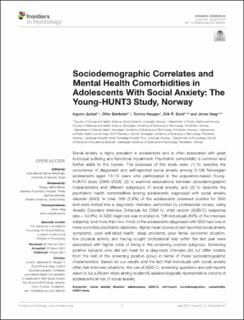| dc.contributor.author | Jystad, Ingunn | |
| dc.contributor.author | Bjerkeset, Ottar | |
| dc.contributor.author | Haugan, Tommy | |
| dc.contributor.author | Sund, Erik | |
| dc.contributor.author | Vaag, Jonas Rennemo | |
| dc.date.accessioned | 2021-08-31T08:05:45Z | |
| dc.date.available | 2021-08-31T08:05:45Z | |
| dc.date.created | 2021-04-20T10:30:51Z | |
| dc.date.issued | 2021 | |
| dc.identifier.citation | Frontiers in Psychology. 2021, 12, . | en_US |
| dc.identifier.issn | 1664-1078 | |
| dc.identifier.uri | https://hdl.handle.net/11250/2771859 | |
| dc.description.abstract | Social anxiety is highly prevalent in adolescents and is often associated with great individual suffering and functional impairment. Psychiatric comorbidity is common and further adds to this burden. The purposes of this study were: (1) to describe the occurrence of diagnosed and self-reported social anxiety among 8,199 Norwegian adolescents aged 13–19 years who participated in the population-based Young-HUNT3 study (2006–2008); (2) to examine associations between sociodemographic characteristics and different subgroups of social anxiety; and (3) to describe the psychiatric health comorbidities among adolescents diagnosed with social anxiety disorder (SAD). In total, 388 (5.9%) of the adolescents screened positive for SAD and were invited into a diagnostic interview, performed by professional nurses, using Anxiety Disorders Interview Schedule for DSM IV: child version (ADIS-C) (response rate = 54.6%). A SAD diagnosis was indicated in 106 individuals (50% of the interview subjects), and more than two-thirds of the adolescents diagnosed with SAD had one or more comorbid psychiatric disorders. Higher mean scores of self-reported social anxiety symptoms, poor self-rated health, sleep problems, poor family economic situation, low physical activity, and having sought professional help within the last year were associated with higher odds of being in the screening positive subgroup. Screening positive subjects who did not meet for a diagnostic interview did not differ notably from the rest of the screening positive group in terms of these sociodemographic characteristics. Based on our results and the fact that individuals with social anxiety often fear interview situations, the use of ADIS-C, screening questions and self-reports seem to be sufficient when aiming to identify epidemiologically representative cohorts of adolescents at risk of social anxiety. | en_US |
| dc.language.iso | eng | en_US |
| dc.publisher | Frontiers Media | en_US |
| dc.rights | Navngivelse 4.0 Internasjonal | * |
| dc.rights.uri | http://creativecommons.org/licenses/by/4.0/deed.no | * |
| dc.title | Sociodemographic Correlates and Mental Health Comorbidities in Adolescents With Social Anxiety: The Young-HUNT3 Study, Norway | en_US |
| dc.type | Peer reviewed | en_US |
| dc.type | Journal article | en_US |
| dc.description.version | publishedVersion | en_US |
| dc.source.pagenumber | 12 | en_US |
| dc.source.volume | 12 | en_US |
| dc.source.journal | Frontiers in Psychology | en_US |
| dc.identifier.doi | 10.3389/fpsyg.2021.663161 | |
| dc.identifier.cristin | 1905231 | |
| dc.description.localcode | Copyright © 2021 Jystad, Bjerkeset, Haugan, Sund and Vaag. This is an open-access article distributed under the terms of the Creative Commons Attribution License (CC BY). The use, distribution or reproduction in other forums is permitted, provided the original author(s) and the copyright owner(s) are credited and that the original publication in this journal is cited, in accordance with accepted academic practice. No use, distribution or reproduction is permitted which does not comply with these terms. | en_US |
| dc.source.articlenumber | 663161 | en_US |
| cristin.ispublished | true | |
| cristin.fulltext | original | |
| cristin.qualitycode | 1 | |

